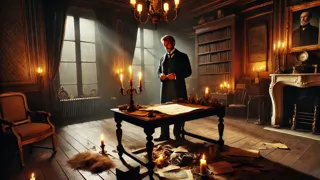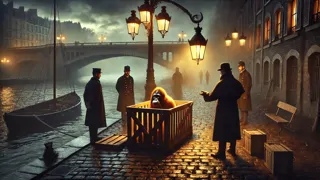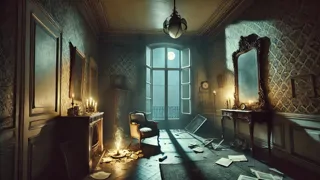Introduction
On a damp spring evening in 1849, the labyrinthine streets of Paris whispered rumors of a ghastly crime. Neighbors in the narrow quarter of Rue Morgue reported blood-curdling shrieks, followed by an eerie silence that settled over the wrought-iron balconies. Inside one aging apartment, a landlady discovered two women – mother and daughter – brutally strangled, their furniture overturned, window shutters torn free, and improbable strands of hair clenched in their lifeless hands. The local magistrate was baffled; no doors had been forced, no locks picked, and no sensible theory could explain how the perpetrator had vanished without a trace. It was into this vortex of terror and uncertainty that C. Auguste Dupin stepped, drawn by the allure of an intractable puzzle. Reclining in his cluttered study, the amateur sleuth surveyed witness statements and forensic oddities with clinical detachment: a broken armchair, inexplicable imprints on the wood floor, and a single guttural cry that no human throat could emit. Every creaking floorboard and displaced shard of porcelain became a cipher awaiting translation, a testament to human ingenuity distorted by violence. As midnight candles guttered and the city’s distant church bells tolled, Dupin immersed himself in the anatomy of the crime scene, determined to extract order from chaos and to prove that, even in darkness, reason could prevail.
A Ghastly Discovery
When the landlady’s trembling hand pushed open the splintered door of 40 Rue Morgue, she stepped into a tableau of horror that would reverberate through every corner of the city. The narrow corridor beyond the threshold reeked of stale perfume and the metallic tang of blood, and a single lantern guttered as if recoiling from the sight. The mother lay sprawled at the foot of a tattered divan, her nightclothes torn, a lock of white hair clutched in her stiffened fist. Further into the room, her daughter’s body slumped against the wall, where smeared handprints rose like accusations. No trace of forced entry remained; the barred window stood intact, and the single exit was secured by an iron bolt that had not been disturbed. Rumors flew—of supernatural intruders, of an escaped convict, of a phantom voice heard crying out. Yet dispatches from the gendarmerie detailed nothing but bleak confusion: footprints that led nowhere, a shattered mirror half hung on the wall, and a tuft of coarse hair unlike any known breed. As dawn crept through the narrow shutters, an uneasy hush fell on the neighborhood. Townspeople gathered in clusters, whispering of curses or impossible feats. But within hours, word reached C. Auguste Dupin, whose curiosity ignited at every improbable detail and whose reputation thrived on the inexplicable.

Dupin arrived at the Rue Morgue lodgings under the pretense of modest interest, but he wasted no time. Blocking out the morbid spectacle of two lifeless forms, he began cataloguing every anomaly: the angle of the dagger embedded in the wall, the elliptical pattern of a crushed porcelain vessel, and the pattern of scuff marks along the threshold. He questioned the landlady with gentle persistence, coaxing out the sequence of distant voices she heard—first a hoarse, human syllable, then a strangled shriek that gorged itself on panic. He examined the witnesses’ statements, uncovering contradictions that hinted at misdirection. By midday, Dupin had already mapped a matrix of probabilities, eliminating the supernatural and the merely opportunistic. The theory he favored remained sensational: an intruder of bestial strength and inhuman cry, guided not by malice but by raw instinct. Yet he refrained from declaration, preferring instead to accumulate evidence as a sculptor chisels away marble, until the form within loomed undeniable.
Word of Dupin’s presence spread through the barracks and salons alike, and by twilight, the magistrate himself conceded to seek the sleuth’s counsel. Within the drawing room adjoining the crime chamber, they poured over a ragged garment snagged on a broken nail, analyzed the distinctive impressions in the plaster, and compared them to prints found in stables at the city’s edge. Dupin’s expression remained calm, almost amused, as he sketched a sequence of events on a scrap of vellum. With each new signpost—the trajectory of a castaway chair, the placement of a toppled lamp, the spatter radius of a single droplet of blood—he edged closer to a solution. It was then that he retrieved the tuft of hair, held it aloft by candlelight, and observed its texture. In that instant, the impossible became inevitable, and Paris held its breath for the first revelation in a case that would stand forever as the prototype of modern detection.
Clues and Contradictions
Under the rigid gaze of the magistrate, Dupin paced the narrow drawing room, tracing the path he believed the killer had taken. He paused at each subtle bend in the path—an ornamental railhouse gone astray, a single shoe print pressed into the soft waxed floor—and retrieved it mentally like a bead on a string. The magistrate frowned at the pattern of misaligned clues, reluctant to admit that they pointed not toward a human malefactor, but toward something more elusive. Yet for every statement of incredulity, Dupin brandished an inference grounded in logic. He noted that the shutters proved heavily reinforced, that no ladder marks blemished the stone exterior, and that the peculiar hair fibers matched neither wolf nor man—and certainly not any breed known to France.

Throughout that day and into the gray dusk, the apartment above Rue Morgue seemed to murmur with unseen presences. Witnesses spoke of guttural howls reverberating through the tenement’s spine, and the city guard reported a lumpish shape glimpsed skulking in the alley at dawn. Dupin visited the surrounding courtyards and cellars, inspecting rope frays in the stables where exotic animals had been kept, and cross-referencing the proprietors’ logs for recent shipments. He found a ledger entry referring to a sailor’s cage, originally destined for the Jardin des Plantes, abandoned at the quay with staves ajar and straw scattered—an anomaly discarded like a broken toy. The pieces fell into place: an unclaimed orang-outang, shipped from distant colonies, accidentally freed and driven by instinct into the nearest open window. The talent for strangling with brute force, the peculiar hair pattern, even the guttural cry—each told a tale of a creature untamed by human civility.
At dusk, Dupin requested a private audience with the magistrate and a small escort of guards. He led them through back alleys to the loading dock on the riverbank, where a barred crate lay half-hidden under tarpaulin. Within its dim confines, the creature lurked with dreadful composure, its black eyes shining in the lantern glow. The arrest was swift, conducted with minimal injury and maximal astonishment. As the guards bound the animal, Dupin calmly recorded the final detail: the absence of human malevolence, replaced by the indifferent brutality of nature. Paris would buzz with gossip of demons and spirits, but the sleuth’s method remained pure: observation, deduction, and respect for evidence—no matter how improbable. Thus did C. Auguste Dupin expose the truth behind the Rue Morgue murders, transforming chaos into a masterpiece of reasoning that no mere rumor or fear could dislodge.
The Shadow of the Orang-Outang
With the creature secured and the magistrate’s approval, Dupin gathered witnesses back at the Rue Morgue apartment. In the cold morning light, the shattered blinds and fractured furniture took on fresh significance: each gouge in the wood, each overturned stool, told the sequence of a desperate struggle for freedom rather than a calculated human crime. The landlady, shaken yet resolute, witnessed two guards ease the great creature through the doorway where it had wrought havoc. She could scarcely believe that the inhuman force she had imagined—some vengeful spirit, perhaps—was in fact flesh, bone, and hair.

Dupin then recapitulated his chain of reasoning. He illustrated how the hair fibers, unlike any local breed of dog or wolf, belonged to a creature acquired on the docks. He re-created the noises reported by neighbors as a series of frightened grunts, misinterpreted through closed shutters. He demonstrated how the orang-outang’s opposable strength and awkward gait explained the broken door latch and the imprints on the floor. Most subtly, he revealed how the creature’s refusal to drag the bodies from sight betrayed the impulsive brutality of a wild animal, not the ritualized cruelty of a human mind seeking vengeance. Each step of his argument dismantled superstition and rumor, replacing them with the austere beauty of deductive clarity.
By sunrise, the Rue Morgue case had passed from mystery into legend. Newsprint across Europe trumpeted the astonishing twist—that no fiendish mastermind lurked in shadowed corners, but an innocent beast driven by survival. Dupin quietly returned to his study, content that reason had triumphed over fear. In the months and years that followed, scholars and storytellers would point to this case as the true genesis of detective methodology: the conviction that every puzzle, no matter how grotesque or improbable, yielded to careful observation and imaginative inference. And though the orang-outang faded back into the lore of exotic menageries, the legacy of Dupin’s reasoning endured, sparking a tradition of criminal inquiry that still guides investigators today.
Conclusion
In the aftermath of the Rue Morgue affair, C. Auguste Dupin returned to his quiet lodgings, leaving behind a Parisian neighborhood irrevocably changed by a crime devoid of human malice yet drenched in terror. The streets resumed their daily rhythm, and the splendid boulevards echoed once more with carriage wheels and merchants’ calls. Yet within the halls of justice and the salons of literature, something fundamental had shifted. No longer would the inexplicable be consigned to whispers of curses or the supernatural. Dupin’s unyielding method—an alliance of precise observation, logical inference, and imaginative possibility—offered a map out of darkness. Detectives would adopt his practice, philosophers would study his arguments, and readers would thrill to the idea that reason could peer into the heart of chaos. The orang-outang that stalked the Rue Morgue may have returned to captivity, but the concept of the detective, as an image of the human mind at its peak, had been set free. In every subsequent mystery, from gaslit alleyways to modern crime labs, the spirit of that first case endures: a testament that, when faced with the unfathomable, the compass of reason never falters.


















